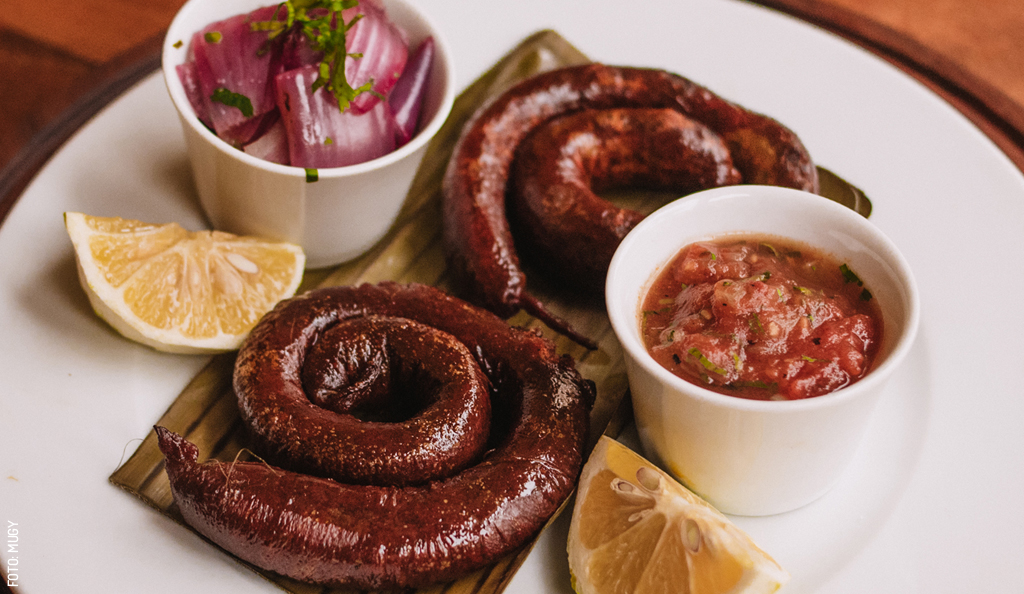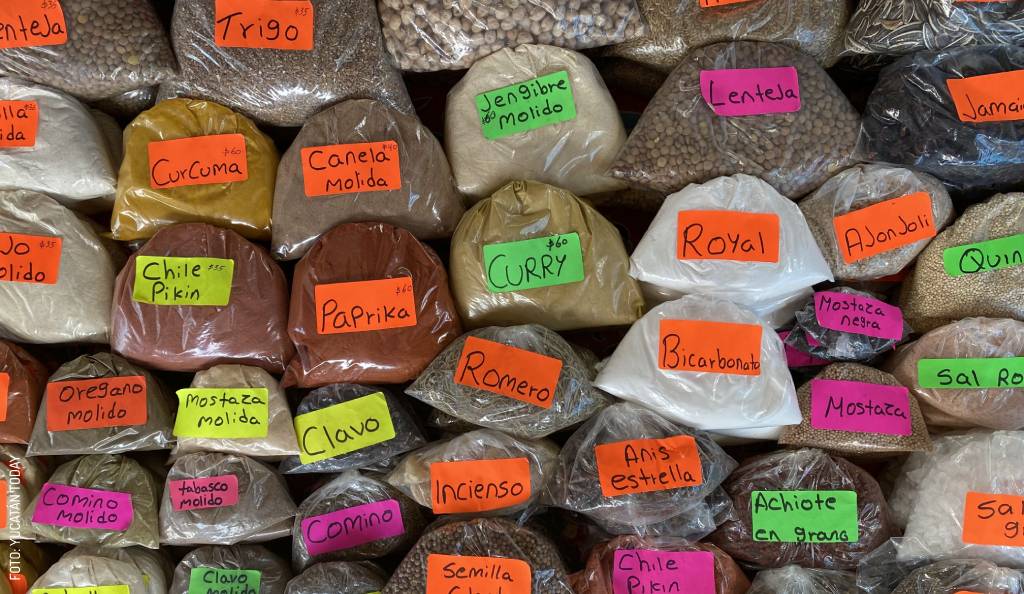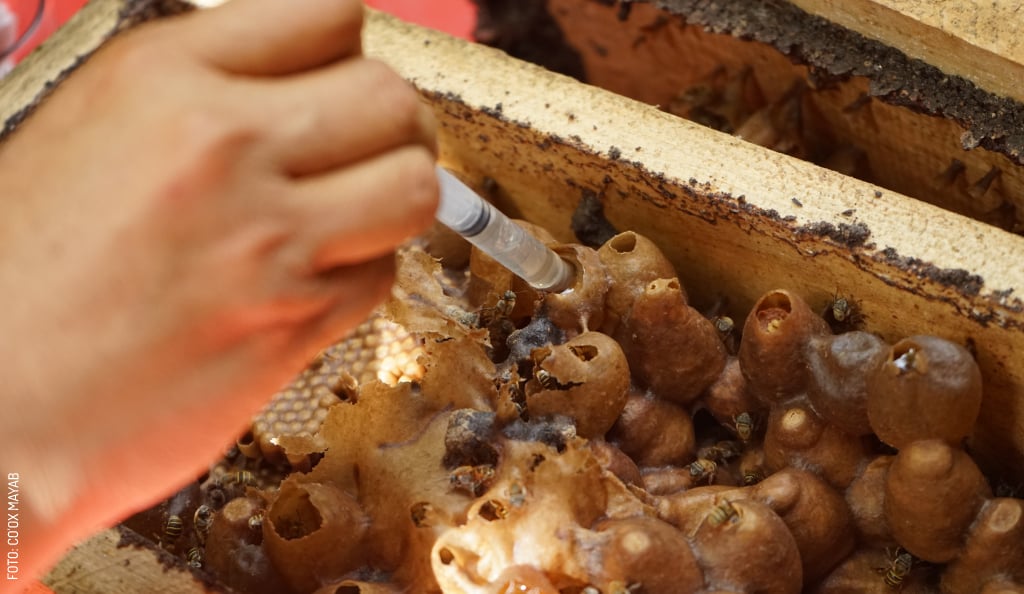Did you know that Yucatán is not only famous for its ancient history, but also for producing one of the most highly valued honeys in the world? With over 9,400 tons of honey in 2023, the state leads national production, contributing around 16% of México’s total output.
This sweet success is nothing new: beekeeping in the peninsula has roots that date back to pre-Hispanic times. Long before the arrival of the European honeybee, the Maya were already raising native stingless bees and harvesting a sacred honey used for ritual, medicinal, and culinary purposes. Today, this ancient heritage lives on in the fields, jungles, and communities that continue to preserve the millennia-old tradition.
Ancestral heritage: Honey in Maya culture
 Beekeeping in Yucatán is deeply rooted in Maya culture, where honey held significant religious, medicinal, and economic importance to the community.
Beekeeping in Yucatán is deeply rooted in Maya culture, where honey held significant religious, medicinal, and economic importance to the community.
Before the Spanish arrived and introduced the European honeybee (Apis mellifera), the Maya raised native stingless bees, mainly the xunáan kaab, or “lady bee” (Melipona beecheii), in hollow logs called “jobones”. These stingless bees were considered sacred, and their honey was seen as a gift from the gods. Maya iconography even includes bee deities, such as Ah Muzankab “He who protects the honey,” and Noh Yum Kab “The Great Lord of the Hives”. The Madrid Codex also features melipona bees drawn with intricate detail.
Melipona honey was indispensable in ceremonies and offerings, and especially prized as a medicine for treating respiratory issues, digestive problems, fevers, and more.
The land, climate, and blossoming flora of the Yucatán Península
Geography and climate
Yucatán’s unique geographic characteristics (its soil composition, lack of surface water, and warm sub-humid climate) give rise to a dry tropical forest ecosystem known as the Mexican dry forest. This forest is composed mostly of “short” trees (usually under 98 ft tall) that shed their leaves during the dry season, creating a rich native flora ideal for honey production.
Yucatán’s nectar-rich flora
The dry tropical forests of Yucatán offer bees a diverse buffet of nectar and pollen sources. Some native plants stand out for the abundance and, above all, the quality of nectar they provide. These factors are what have led to the international fame that Yucatecan honey proudly enjoys. Among the most emblematic nectar-producing species are Plateau Goldeneye or tajonal (Viguiera dentata), the dzidzilché (Gymnopodium floribundum), the Florida fishpoison tree (Piscidia piscipula), the kanchunup or k'aan chunukub (Thouinia paucidentata), and various native vines, just to name the most well-known.
Yucatán’s honey calendar
In Yucatán, beekeeping follows the rhythm of the dry (winter–spring) and rainy (summer–fall) seasons, as follows:
- Winter (November–February), the Plateau Goldeneye blooms in abundance, kicking off the main honey harvest season.
- Spring (March–May), trees like dzidzilché bloom, making this the period when up to 80% of the year’s honey is collected.
- When summer arrives (June-September), constant rains reduce blooming and bee activity, lowering honey production.
- In what is considered the Yucatecan fall (during October), we see a brief recovery with minor blooms; it is a period of preparation for the new cycle.
Not all honey is created equal
 We know bees produce honey, but how exactly does it happen?
We know bees produce honey, but how exactly does it happen?
Bees collect nectar from flowers and transform it inside the hive using digestive enzymes and constant fanning. Once the nectar becomes honey, bees store it in honeycombs and seal it with wax. Beekeepers then harvest the surplus without harming the colony, filter it, and bottle it. It’s a natural process that turns the nectar of thousands of flowers into a nutritious, delicious food.
Types of Yucatecan honey
Honey can be classified in several ways. In Yucatán and México, the most common methods are based on the bee species that produced it, the floral origin of the nectar, and its physical and sensory characteristics (aroma, color, flavor).
- By bee species:
The main distinction here is between honey produced by European honeybees (Apis mellifera) and that of native stingless bees (the most famous being Melipona beecheii, though it’s not the only one). A European bee colony can produce up to 110 lb of honey per year, while a melipona hive typically yields no more than 1.5 liters annually.
- By floral origin:
Honey can be monofloral or multifloral. Monofloral honey is produced mainly from the nectar of one dominant plant species, giving it unique traits. For example, in Yucatán, two monofloral honeys stand out:
![Flor-Dzidzilche-gymnopodium-floribundum-by-Andrea-Mier-y-Teran]() The Dzidzilché honey has an intense floral aroma with a caramel-like touch and a dark amber color deeper than other local honeys. It’s perhaps the most famous honey from Yucatán, known for its exquisite flavor and aroma. So much so that there is an international market for dzidzilché honey: it is generally exported to Europe, where it is considered a gourmet ingredient.
The Dzidzilché honey has an intense floral aroma with a caramel-like touch and a dark amber color deeper than other local honeys. It’s perhaps the most famous honey from Yucatán, known for its exquisite flavor and aroma. So much so that there is an international market for dzidzilché honey: it is generally exported to Europe, where it is considered a gourmet ingredient.![Flor-Tajonal-viguiera-dentata-by-Andrea-Mier-y-Teran]() If you've ever seen honey with a light yellow or pale amber color, with golden hues, chances are you've come across tajonal honey. Tajonal is a wild plant often found along roadsides and highways, adorned with bright yellow flowers. Tajonal honey has a very mild, sweet, and floral flavor, and tends to crystallize easily due to its composition. It’s important to know that this is a 100% natural process of pure tajonal honey and does not indicate any kind of adulteration. To return it to its liquid state, you simply need to warm it up a bit.
If you've ever seen honey with a light yellow or pale amber color, with golden hues, chances are you've come across tajonal honey. Tajonal is a wild plant often found along roadsides and highways, adorned with bright yellow flowers. Tajonal honey has a very mild, sweet, and floral flavor, and tends to crystallize easily due to its composition. It’s important to know that this is a 100% natural process of pure tajonal honey and does not indicate any kind of adulteration. To return it to its liquid state, you simply need to warm it up a bit.
- According to flavor and aroma
Each type of honey offers a unique profile closely tied to the dominant blooming plant. In this way, monofloral honeys have distinctive flavors unique to their floral source, while multifloral honeys are a blended composition that reflects the nectar-bearing flora of the region.
The community beehives
 Beekeeping is not only an ancestral tradition in Yucatán, but also a strategic economic activity for its inhabitants. For the past decade, Yucatán has remained the leading honey-producing state in México.
Beekeeping is not only an ancestral tradition in Yucatán, but also a strategic economic activity for its inhabitants. For the past decade, Yucatán has remained the leading honey-producing state in México.
We had the pleasure of speaking with Guillermo Hernández Cruz, who has been dedicated to beekeeping for over 35 years. He began with just two “boxes” or hives, which are the wooden structures that house bee colonies. Today, Guillermo owns approximately 400 hives spread across the state and devotes himself full-time to honey production, as well as providing technical advice to other beekeepers in Yucatán.
“Everything you see here is thanks to beekeeping,” he says, pointing to his house and his vehicle.
He tells us that beekeeping has allowed him to raise his three children and give them a university education, as well as acquire a home and a work vehicle. And the positive impact goes beyond that, Don Guillermo also employs several people in the various communities where his apiaries are located.
The challenges: climate change and low prices
 Don Guillermo explains that, in his view, the two main problems facing beekeeping today are the low price of honey and the impact of climate change on the local ecosystem.
Don Guillermo explains that, in his view, the two main problems facing beekeeping today are the low price of honey and the impact of climate change on the local ecosystem.
Yucatecan honey is an export product; it is estimated that between 85% and 90% of the honey produced in Yucatán is destined for international markets, primarily the European Union. This means that the price of honey is tightly linked to external factors beyond the control of local beekeepers.
Don Guillermo explains that nearly all beekeepers sell their production wholesale, either to collection centers or intermediaries who then export it abroad. This is because there is not enough domestic demand for honey. Some beekeepers do take advantage of the opportunity to bottle a relatively small amount and sell it locally to friends and family.
“The wholesale price per kilo of honey used to go as high as $60 pesos a few years ago, but nowadays it's no more than 35 pesos.”
As honey prices drop, profits decrease, and production declines. This pushes beekeepers to look for more profitable economic alternatives.
Another major issue for Yucatecan beekeeping is climate change. Don Guillermo tells us that when he first started in the business, there was an abundance of tajonal blooms in his area. Nowadays, tajonal is no longer found there. Additionally, droughts are becoming more severe, and rainfall arrives out of season and is more intense. All of these factors affect local flora, causing it to bloom earlier or later than usual, unlike how it always had before.
A tradition for the future
 Yucatecan honey is much more than a food product—it is living history, culture, economy, and nature. From ancient Maya codices to modern apiaries, this tradition has evolved without losing its essence.
Yucatecan honey is much more than a food product—it is living history, culture, economy, and nature. From ancient Maya codices to modern apiaries, this tradition has evolved without losing its essence.
Caring for bees, preserving flowers, and valuing honey for what it truly is, a treasure of nature, is a responsibility we all share as inhabitants of this planet. To help protect our local environment, we encourage you to buy authentic Yucatecan honey; you can find it in places like markets, fruit shops, and bazaars. It is also often sold through social media. You can expect to pay between $100 and $150 pesos for a liter of Yucatecan honey, which is roughly equivalent to 3 lb.
First published in Yucatán Today print and digital magazine no. 451, in July 2025.

Author: Gonzalo N. González
Yucatecan accountant. Lover of nature, video games, plants, new places, and silence.
Receive the latest articles and much more from the best of Yucatán in your email!
Related articles

Yucatán's Handcraft, Perfect to Take Home!
Discover the rich handcraft traditions of Yucatán, from intricate filigree jewelry to handwoven hammocks and embroidered garments. Explore where to...
The Flavors of Yucatán
Visiting Yucatán? Just moved? Learn everything you need to know about the flavors of the Yucatecan cooking.




 The Dzidzilché honey has an intense floral aroma with a caramel-like touch and a dark amber color deeper than other local honeys. It’s perhaps the most famous honey from Yucatán, known for its exquisite flavor and aroma. So much so that there is an international market for dzidzilché honey: it is generally exported to Europe, where it is considered a gourmet ingredient.
The Dzidzilché honey has an intense floral aroma with a caramel-like touch and a dark amber color deeper than other local honeys. It’s perhaps the most famous honey from Yucatán, known for its exquisite flavor and aroma. So much so that there is an international market for dzidzilché honey: it is generally exported to Europe, where it is considered a gourmet ingredient. If you've ever seen honey with a light yellow or pale amber color, with golden hues, chances are you've come across tajonal honey. Tajonal is a wild plant often found along roadsides and highways, adorned with bright yellow flowers. Tajonal honey has a very mild, sweet, and floral flavor, and tends to crystallize easily due to its composition. It’s important to know that this is a 100% natural process of pure tajonal honey and does not indicate any kind of adulteration. To return it to its liquid state, you simply need to warm it up a bit.
If you've ever seen honey with a light yellow or pale amber color, with golden hues, chances are you've come across tajonal honey. Tajonal is a wild plant often found along roadsides and highways, adorned with bright yellow flowers. Tajonal honey has a very mild, sweet, and floral flavor, and tends to crystallize easily due to its composition. It’s important to know that this is a 100% natural process of pure tajonal honey and does not indicate any kind of adulteration. To return it to its liquid state, you simply need to warm it up a bit.
